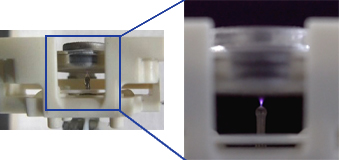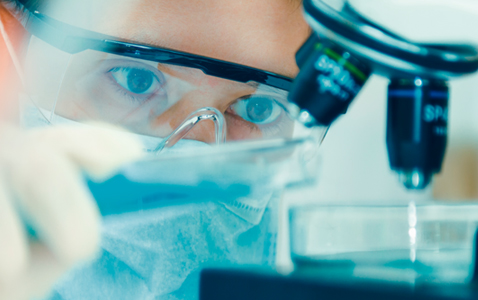History of devices to generate hydroxyl radicals contained in water
Background
The origin of hydroxyl radicals contained in water
It all began in 1997. Working on a project of the former Ministry of International Trade and Industry on purification of air in living environments, Panasonic researchers became interested in a technology for generating hydroxyl radicals contained in water. They wondered if tiny water particles could provide a new way to clean air. And in 2001, a team of just two researchers set to work.
This was entirely new technology, and it presented significant challenges. The team needed to develop verification methods and evaluation techniques from the ground up, and the electrical discharge phenomenon at the core of the process was difficult to control. The work continued without results for some time, and at one point the research was nearly abandoned. However, the research director at the time decided to persevere, saying, "Let's keep at it for one more year!" Panasonic devotion to technology saved the project. And finally, in 2003, the team succeeded in creating nano-sized water particles that purify the air. The technology of hydroxyl radicals contained in water was born.
Timeline
What are hydroxyl radicals contained in water [4800] (nano-sized electrostatic atomized water particles)?
In 2016, Panasonic enhanced the discharge component of the hydroxyl radicals contained in water [480] device (generates 480 billion hydroxyl radicals per second*¹), succeeding in creating a hydroxyl radicals contained in water [4800] device (generates 4.8 trillion hydroxyl radicals per second*²) that produces 10 times*³ the hydroxyl radicals with an unchanged ozone generation level.
Hydroxyl radicals contained in water [480] | Hydroxyl radicals contained in water [4800] | ||
|---|---|---|---|
Ion | Illustration |  |  |
Method | Discharge system | Electrostatic atomization (corona discharge) | Electrostatic atomization (multi-leader discharge) |
Condensation method | Peltier method | ||
Basic features | Electric charge | Minus | |
Size | 5 to 20 nm | ||
Hydroxyl radicals | 480 billion/second | 4.8 trillion/second | |
Ion lifespan | About 600 seconds | ||
Water content | About 1,000 times | ||
Characteristics | Mild acidity | ||
Generating principle |  A generator for hydroxyl radicals contained in water [480] cools and condenses water from the air. A high voltage is applied to the collected water to generate hydroxyl radicals contained in water. |  In the generator for hydroxyl radicals contained in water [480], radicals are discharged in a radial dispersion. On the other hand, the generator for hydroxyl radicals contained in water [4800] generates a broad plasma region by discharging at one point, generating 10 times*³ as many hydroxyl radicals. | |
Discharge condition |  |  | |
*¹ Generator for hydroxyl radicals contained in water [480] measured by ESR method in September 2010. (Panasonic research)
*² Generator for hydroxyl radicals contained in water [4800] measured by ESR method in September 2016. (Panasonic research)
*³ Comparison between generator for hydroxyl radicals contained in water—480 billion particles per second—and generator for hydroxyl radicals contained in water—4.8 trillion particles per second. Measurement by ESR method. (Panasonic research)


















